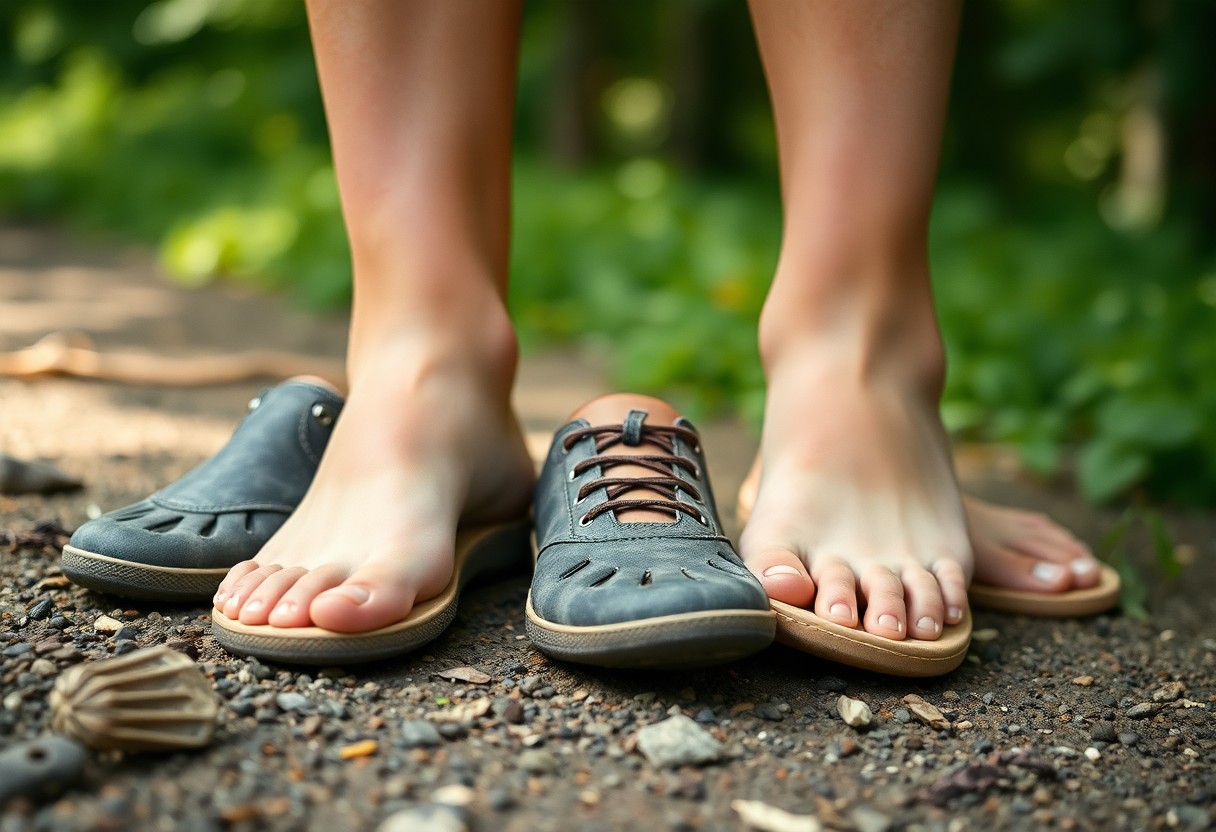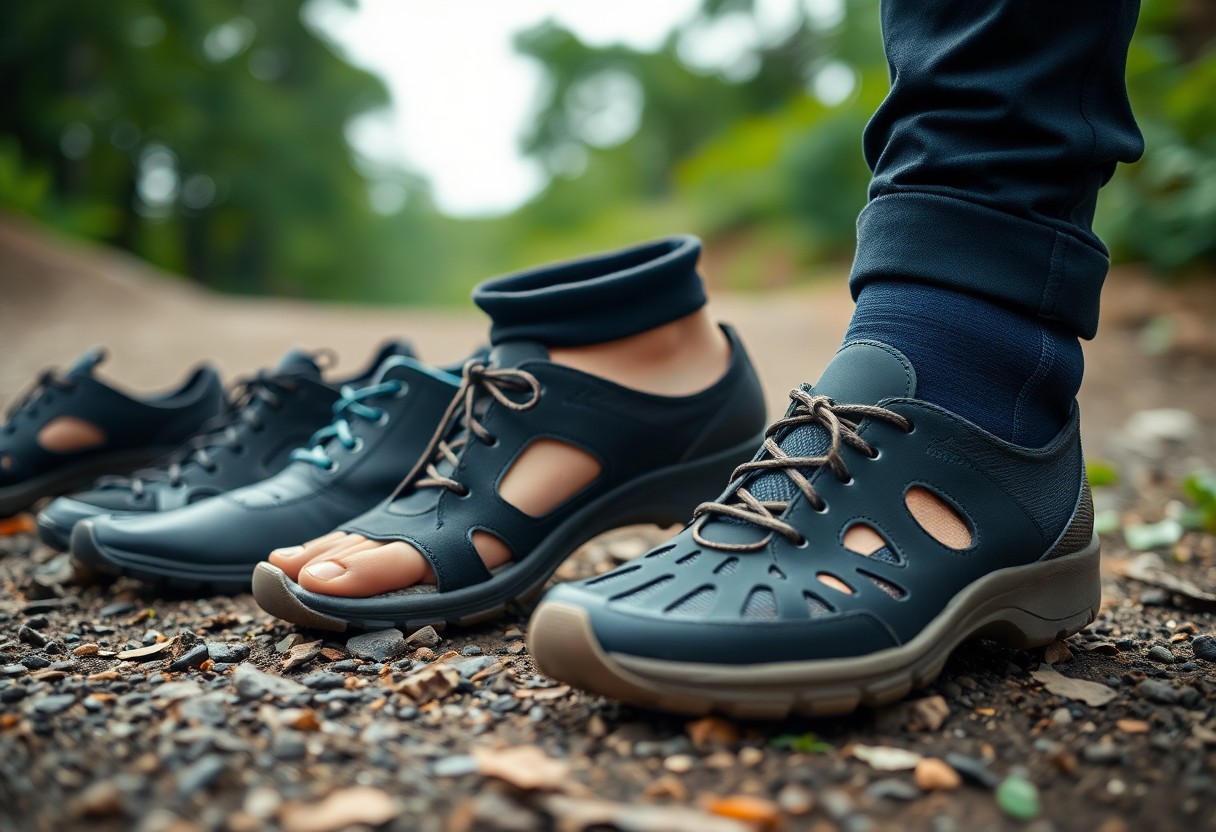
The realm of barefoot footwear has experienced remarkable changes, propelled by innovative breakthroughs in material engineering. These advancements provide unmatched comfort and performance for individuals in search of a more organic walking experience. This detailed exploration will uncover how cutting-edge technologies are transforming shoe design, with Vibram soles at the forefront, delivering not only exceptional ground feel but also strong protection against diverse terrains. As we dive deeper, you will learn about sustainable manufacturing techniques that significantly lessen the environmental impact while improving the durability and functionality of barefoot shoes. The integration of biomechanics, advanced materials, and eco-friendly production methods is redefining the minimalist footwear landscape, heralding a future where comfort, performance, and sustainability coexist seamlessly.

Comprehensive Analysis of TPU and EVA: Unpacking Material Performance
Within the sphere of barefoot footwear engineering, Thermoplastic Polyurethane (TPU) and Ethylene-Vinyl Acetate (EVA) emerge as two pivotal materials, each presenting distinct performance characteristics. Manufacturers meticulously analyze the molecular structures, thermal behaviors, and mechanical responses of these materials to make informed decisions about their applications in footwear. The ongoing discourse focuses on how these polymers behave under dynamic stresses, weight distributions, and varying environmental conditions. For instance, TPU is celebrated for its exceptional durability and resilience, while EVA is generally favored for its superior cushioning properties. Each material caters to specific user preferences and performance demands, making them suitable for a variety of activities and settings.
Determining Flexibility in Footwear: Which Material Excels?
Flexibility plays a crucial role in the design of barefoot shoes, as the responsiveness of the material greatly enhances the overall user experience. TPU exhibits superior flexibility at lower temperatures, maintaining its structural integrity across a broader range of environmental conditions compared to traditional EVA compounds. This intrinsic flexibility ensures that wearers can experience optimal comfort and adaptability, regardless of the climate or terrain they encounter. Ultimately, the choice between these materials influences not only the feel of the shoe but also the performance during various activities, making it a vital consideration for consumers.
| Comparative Analysis of Material Properties | Performance Metrics |
|---|---|
| TPU Flexibility Range | -40°C to 80°C |
| EVA Flexibility Range | -20°C to 60°C |
Examining Abrasion Resistance: Crucial Insights from Taber Test Outcomes
The ability of a material to resist abrasion is vital for ensuring the longevity and optimal performance of footwear. Taber test results have demonstrated TPU's remarkable wear characteristics, showing significantly lower mass loss percentages compared to conventional EVA formulations. These findings highlight the necessity of selecting durable materials in footwear design. Microscopic examinations of TPU's molecular structures reveal its impressive resilience against mechanical wear, with researchers documenting TPU's capacity to maintain structural integrity even after 10,000 abrasion cycles. This represents a significant advancement in the material science related to barefoot footwear. The cross-linked molecular configuration of TPU facilitates optimal load distribution, effectively diminishing localized stress points and minimizing material fatigue. Insights gathered from these studies are now steering manufacturers toward developing sophisticated, performance-driven barefoot shoe designs that seamlessly balance flexibility, durability, and user comfort.

Leading the Charge in Sustainable Footwear Practices: A Transformative Era
The evolution of sustainable footwear manufacturing has transitioned from a niche concept to a vital strategic focus within the industry. Prominent brands like Xero Shoes and Vibram are leading innovative methodologies that incorporate recycled materials, processes aimed at drastically reducing waste, and pioneering design techniques. The principles of material recovery and the establishment of a circular economy are now central to product development, fundamentally changing how barefoot shoe manufacturers approach environmental responsibility and production efficiency. This transition not only boosts the sustainability of their products but also appeals to eco-conscious consumers.
Analyzing the Life Cycle of Recycled PET Uppers Utilized by Xero Shoes
Xero Shoes demonstrates a strong commitment to sustainability through its use of recycled PET upper materials, which convert plastic waste into high-performance components for footwear. Remarkably, each pair of shoes repurposes around 3-5 plastic bottles, significantly minimizing the environmental footprint while maintaining high standards of durability and performance. Their life cycle analysis reveals substantial reductions in carbon emissions and waste when compared to traditional manufacturing methods, underscoring the effectiveness of sustainable strategies in the world of barefoot footwear. This dedication to sustainability not only benefits the environment but resonates with consumers prioritizing eco-friendly choices.
Comparing Carbon Footprints: Traditional Manufacturing Versus Eco-Friendly Options
Traditional shoe manufacturing processes contribute significantly to carbon emissions, with conventional methods generating approximately 30 pounds of CO2 for each pair of shoes produced. However, eco-friendly alternatives can decrease these emissions by up to 60%, utilizing renewable energy sources, recycled materials, and efficient production practices. Barefoot shoe manufacturers are at the forefront of this transformative movement, rethinking material sourcing and production techniques to create environmentally responsible footwear that aligns with consumer values regarding sustainability.
In-Depth Carbon Footprint Evaluation: Sustainable vs. Conventional Manufacturing Practices
A closer examination of carbon footprint evaluations reveals intricate distinctions between traditional manufacturing methods and sustainable practices. Conventional shoe production heavily relies on petroleum-based materials and energy-intensive processes, accompanied by complex global supply chains. Conversely, sustainable manufacturers like Xero Shoes prioritize local production, renewable energy, and closed-loop material systems. By emphasizing the use of recycled materials, minimizing transportation distances, and enhancing manufacturing efficiencies, these brands can lower their carbon footprint from an average of 30 pounds to as little as 12 pounds per shoe. This reduction signifies a remarkable step forward in the quest for environmentally friendly footwear engineering, appealing to an ever-growing demographic of eco-conscious consumers.

Understanding Durability: Insights from Wear Patterns
The wear patterns observed in barefoot footwear provide invaluable insights into the intricate relationships among material composition, user biomechanics, and environmental stressors. Advanced computational mapping techniques are now being employed to track microscopic zones of degradation, enabling manufacturers to accurately predict performance trajectories. Researchers are focusing on analyzing stress concentrations at critical flex points, observing how various molecular structures react to repeated mechanical loading across different terrain types, ensuring that the footwear remains effective regardless of the environment.
Long-Distance Durability Research: Performance Across Varied Terrains
Longitudinal studies examining the performance of barefoot shoes have highlighted exceptional resilience in next-generation materials. Experimental prototypes have shown their structural integrity across challenging environments, such as rugged mountain trails, urban concrete surfaces, and arid desert landscapes, with minimal degradation. Precision laser scanning revealed less than 12% material compression after 500 miles of continuous use, marking a significant breakthrough in the long-term wearability of barefoot footwear. This durability not only enhances user satisfaction but also prolongs the product's life cycle, contributing to sustainability.
Innovations Addressing Microbial Growth: Utilizing Vegan Materials
Emerging vegan materials are now incorporating nano-silver antimicrobial technologies, resulting in self-sanitizing surfaces that substantially reduce bacterial colonization. The integration of silver ions within synthetic fibers effectively prevents odor development and inhibits microbial growth, thereby extending the functional lifespan of barefoot footwear in extended usage scenarios. Tackling microbial resistance poses a complex engineering challenge that demands a multidisciplinary approach. Researchers have created sophisticated polymer blends that include natural antimicrobial agents, such as chitosan derived from crustacean shells, alongside plant-based compounds like tea tree oil extracts. Molecular engineering techniques now enable the precise distribution of these agents throughout material substrates, forming a continuous protective barrier against bacterial and fungal proliferation. These advancements not only enhance hygiene but also improve material durability, reducing environmental waste by extending product lifecycles while preserving performance characteristics under challenging conditions.
Imagining the Future of Footwear Engineering: Innovations and Trends
The swift rise of biomimetic technologies is significantly altering the landscape of barefoot footwear design, with nanotechnology and responsive materials leading this evolution. Researchers are innovating smart textiles that adapt to varying temperatures and terrains, integrating sensors that analyze gait dynamics in real-time. Major brands like Adidas and Nike are actively exploring the use of 3D-printed midsoles that can be customized to individual foot biomechanics, potentially lowering injury risks by as much as 35%. Sustainable manufacturing methodologies that utilize recycled ocean plastics and bio-based polymers are increasingly becoming the industry standard, with projections indicating that 75% of performance footwear may be produced using circular economy principles by 2030. This shift not only mirrors consumer demand for sustainability but also signifies a major evolution in the footwear industry.
Here’s the paragraph:
Key Takeaways from Material Engineering in Footwear
In summary, the advancements in Material engineering have fundamentally transformed the design of barefoot footwear, reshaping your understanding of both comfort and performance. Your investigation into Vibram soles and sustainable manufacturing techniques uncovers a complex interplay between biomechanics, advanced materials, and a commitment to environmental awareness. By adopting innovative technologies and eco-friendly production methods, the contemporary landscape of barefoot footwear manufacturers is not only focused on creating shoes; they are engineering comprehensive solutions that enhance your natural movement while minimizing ecological impact. These significant advancements illustrate how cutting-edge material science continues to redefine your footwear experience, paving the way for a more sustainable and comfortable future.
Here’s a detailed FAQ about Material Engineering in Modern Barefoot Footwear:
Frequently Asked Questions about Material Engineering in Barefoot Footwear
Q: How do Vibram soles improve barefoot footwear technology?
A: Vibram soles signify a major advancement in the design of barefoot shoes, utilizing advanced rubber compounds that offer exceptional grip, flexibility, and durability. These specially engineered soles replicate natural foot movement, featuring anatomically designed treads that evenly distribute weight and enhance sensory feedback from the ground. This innovative design allows wearers to experience a more organic walking and running experience, making them ideal for a variety of activities.
Q: What sustainable manufacturing techniques are emerging in barefoot footwear production?
A: Modern manufacturers of barefoot footwear are increasingly embracing innovative sustainable practices, such as sourcing recycled rubber, utilizing bio-based synthetic materials, and implementing low-waste production techniques. Companies are progressively incorporating recycled plastic bottles, organic cotton, and responsibly sourced natural rubber to create eco-friendly shoes that minimize their environmental impact while ensuring high performance standards that meet consumer expectations.
Q: In what ways does material engineering enhance the biomechanical performance of barefoot shoes?
A: Material engineering enables manufacturers to maintain precise control over shoe flexibility, weight, and tactile sensitivity. Advanced composite materials such as lightweight polymers and engineered mesh fabrics facilitate zero-drop designs that promote natural foot alignment, enhance proprioception, and alleviate muscular strain. These engineered materials also provide optimal temperature regulation, moisture-wicking properties, and structural support, effectively mimicking the foot's natural biomechanical functions for improved overall performance.
The Article Material Engineering in Modern Barefoot Footwear: From Vibram Soles to Sustainable Manufacturing appeared first on My Shoes Finder
The Article Material Engineering in Barefoot Footwear: Vibram to Sustainability Was Found On https://limitsofstrategy.com
The Article Material Engineering in Footwear: From Vibram to Sustainability First Appeared ON
: https://ad4sc.com








Your exploration of the evolution in barefoot footwear is both fascinating and timely. The way material engineering is shaping our walking experiences truly reflects a broader movement towards more mindful, sustainable living. As someone who has recently transitioned to minimalist footwear, I can attest to the incredible difference in comfort and ground feel that these innovations bring, especially during long walks or runs.